Here you will find a practical strategy to plant in ceramic pots without drainage holes and pro tips that will guarantee your success.
Are you a fan of ceramic planters and want to take advantage of planting in pots without holes too? If you are worried about root rot and other problems with planting in a cachepot, I will show you how to do it.
First, we will talk about the benefits of Ceramic pots for houseplants and then I will show you how to plant in ceramic cachepots by improving the drainage of soil and other ways. Finally, I will tell you pro tips about potting in planters without holes.
If you are ready. Let’s dive into it.
Are ceramic pots good for indoor plants?
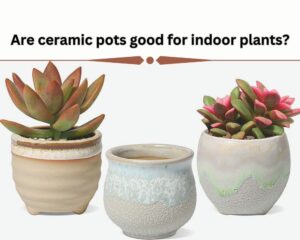
Before diving into “How to plant in ceramic pots without drainage holes“, let to explore whether are ceramic pots good for indoor plants or not. I think they are one of the best pots for indoor plants, although they have pros and cons.
In the following, I notice two important tips for using ceramic pots that are related to planting in pots without drainage too. If you are interested in knowing more tips about planting in Ceramic pots, please read “Are ceramic pots good for indoor plants? A comprehensive guideline”
Advantages of using Ceramic Planter Pots without drainage holes
First, let’s tell you several advantages of using Ceramic pots for your plant:
- The ceramic pots are durable enough to last a long time.
- They are nice to look at with various sizes and shapes.
They have specifications that benefit your plant such as the porous nature of these Pots. The importance of using porous pots (such as Ceramic pots) for plants are:
- Root Revitalizer: The porous nature of ceramic pots improves permeating airflow into the soil. Hence, a lot of air inside the soil stimulates the roots to more growth.
- Decreasing the risk of root rot: The risk of root rotting rises in soggy soils often leads to plant death. The Ceramic pots are perfect to mitigate extra water in the soil. They pull the moisture out of the soil due to their porous nature.
So, ceramic planters without drainage holes are perfect for planting house plants in pots without drainage holes. It is due to their ability to absorb over-water from the wet soils.
Disadvantages of using Ceramic Planter Pots without drainage holes.
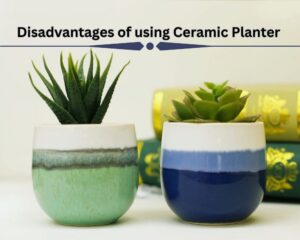
Here we only talk about the cons of using ceramic pots without drainage holes. If you are interested in more about choosing the best planter for your houseplant please read “Best pots for indoor growing”.
Risk of drying: As you found out above, ceramic planters because of their porous nature, absorb more water compared to plastic pots. In the following, we will say you must irrigate less during planting in pots without drainage holes.
Hence, if you forget water, the risk of wilting your plant will be increased in ceramic pots. However, the water flow is restricted in glazed ones.
Do ceramic pots need drainage holes?
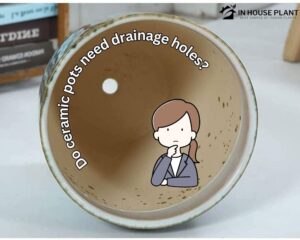
As mentioned above ceramic pots can absorb water from soil, although it is a good ability but it’s not enough for removing the excess water from the soil. Hence, the ceramic pots need a drainage system. But you must know there is a difference between soil drainage and drainage holes.
The holes in the bottom of planters are one of the ways (not the only way) for creating drainage in potted soil. However, drainage holes are the best and most efficient method for creating drainage.
So, if you can improve the drainage in ceramic pots without holes (by the ways that will be mentioned in the following), they will be good planters for your indoor plant.
Can you plant in ceramic pots without drainage holes?
Yes, you can. There are several advantages to planting into pots without holes such as they are cleaner and without any dirty water flowing from their bottom holes. These benefits encourage people to use cachepots for planting houseplants. If you want to know more, read “Why do some plant pots not have holes?”
Ceramic pots, due to their beautiful appearance and variegated colours and shapes, are more popular among indoor gardeners. If you can make good drainage inside them by adding rocks, active charcoal, light soil, monitoring the moisture, and creating other suitable conditions, you can plant in ceramic pots without drainage holes.
How to plant in ceramic pots without drainage holes?
In this part, I will show you how to pot plants in a ceramic cachepot without drainage holes. If you follow the below instructions and tips, your plant will thrive without any worry about root rot.
1- Select an appropriate ceramic pot without holes.
The size of your pot must be suitable for your plant. Avoid choosing the large ceramic planter that makes you add more water to it which is extra of the needs of roots. As you know in pots without drainage holes the water remains inside the soil. Hence, more soil, more moisture.
Thy to select tall ceramic pots instead of shallow ones. As you will find out in the following, you have to make a reservoir in the bottom of your pot. In a tall planter, you have more space to do it.
2- Clean and disinfect your ceramic pot.
The risk of root rot in planters without holes is higher than in other pots. Hence, you must remove the fungal and bacteria that may have stayed in the remained soils and debris in an old pot. Remove the remained soil and debris, disinfect the pots with a bleach solution (one part bleach plus 9 parts water), and then wash the ceramic pot.
I discussed the ways to prevent root rot in pots without holes in my previous article, too.
3- Add drainage rocks at the bottom of the ceramic planter.
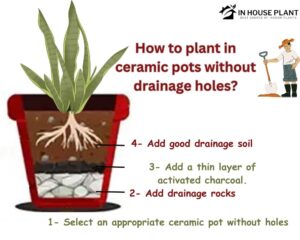
Now it is time to build a depot in the bottom of your ceramic cachepot. The excess water will accumulate there and be taken far from the roots.
To do it, you have to add layers of drainage rocks at the bottom of your pot. Depending on the size of your planter, you should fill ¼ of your ceramic pot with pebbles or landscape rocks.
4- Add a thin layer of activated charcoal.
It plays as a reward to your plant. Activated charcoal can absorb water, hence helping soil drainage of your ceramic pot to take the excess water away from the roots.
In addition, activated charcoal has antibacterial and antifungal activity too. It is very important for planting in pots without holes because plants that thrive in a cachepot are more susceptible to root rot.
5- Prepare good drainage soil for your plant.
One of the critical factors in potting in ceramic planters without holes is you improve the drainage ability of soil. You have to use light-potted soil.
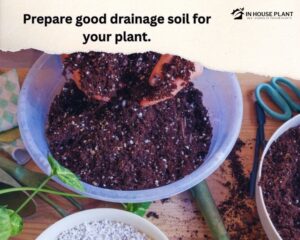
Adding Soil Amendments such as perlite, horticultural charcoal, pumice, orchid bark, and vermiculite has several benefits including:
- Improve the soil structure and keep the soil from being compacted.
- Help to airflow in soil and provide more aeration.
- After adding the Soil Amendments, water dispersing will be more evenly through the soil.
Now your ceramic pot without drainage hole is ready for planting but if you want to be successful, you must observe the following points too.
Pro tips for the healthy thriving of plants in ceramic pots without holes
Unglazed ceramic planters
The glazed ceramic pots can save more moisture in the soil than the unglazed ones. Hence, when you want to plant in a ceramic pot without holes you should choose an unglazed one to help you in removing extra water.
Watering your plant moderate to low
When you water a plant in a ceramic pot without a hole, the excess water doesn’t remove the soil and stays there. Hence it is critical to avoid over-watering and give only intake water of your plant. I discussed best practices for watering in pots without holes in my previous article, you can read it to find more details.
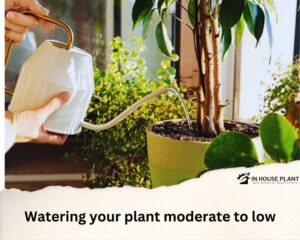
Watering your plant slowly
When you add a lot of water to a ceramic pot without holes suddenly, the water will pass through the soil quickly and accumulate in the bottom of the pot and create a pool there. but when you water slowly, the water evenly distributes through the soil. In this situation, although you add less volume of water to the soil the roots have more time to absorb the water.
Remove the excess water
If you have a heavy hand in watering, you have to tip the pot over (or to the sides) till the extra water spills out. Don’t worry about a little soil that may be lost, replace it later in your pot.
Select the best plants for ceramic pots without drainage holes
All indoor plants cannot grow in pots without holes. If you want to have healthy plants, you should choose one that can tolerate wet soils or even grow in almost drought soils. You may think these plants are in contrast, read “what plants can grow in pots without drainage holes” to find out its reason in more detail.
In the following you can see a list of plants that can grow in pots without holes:
- Rough Horsetail
- Succulent
- Snake plants
- ZZ plant
- Baby’s Tears
- Boston Fern
- Maidenhair Fern
- Chinese evergreen
- Dumb cane
- Spider plant
- Pothos
If you are interested in finding more plants, you can read the following article and make your favourite list.
- Herbs that don’t need drainage.
- Flowers that don’t need drainage holes.
- What hanging plants don’t need drainage?
- Small indoor plants without drainage holes.
- Succulents that don’t need drainage.
Conclusion
Now you learned how to plant into a ceramic planter without drainage holes. I provided you with a lot of pro tips that will help you to be successful and have healthy plants. Have you ever experienced planting in a ceramic pot without holes? Do you think the above strategy will work well? Can you add other tips about planting in cachepots to our list? Please share your idea with us below this page and let our readers know about your experiences.

Elahe Rabiei
Hi, I’m Elaheh. My Academic major is plant protection, and houseplants are my expertise. As a houseplant lover, my house is full of indoor plants and it is my passion to take care of them. Hence, I’m here to share my knowledge and experience about growing healthy houseplants. I am also a plant protection advisor, so feel free to ask me any questions you may have.

